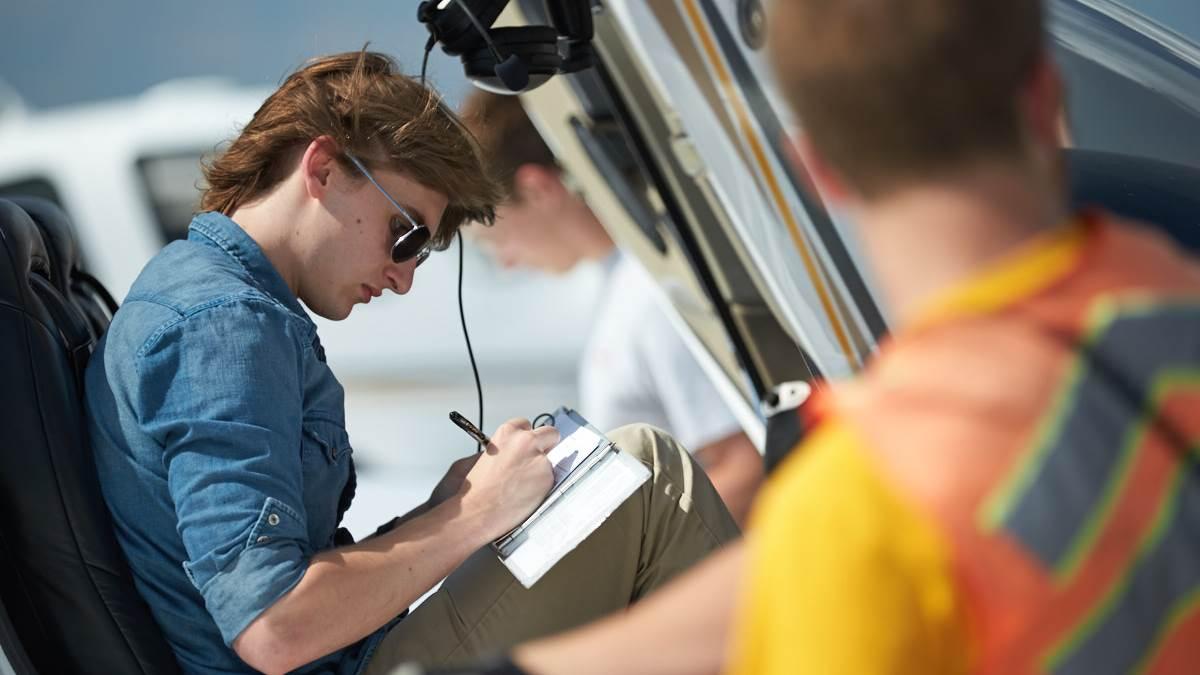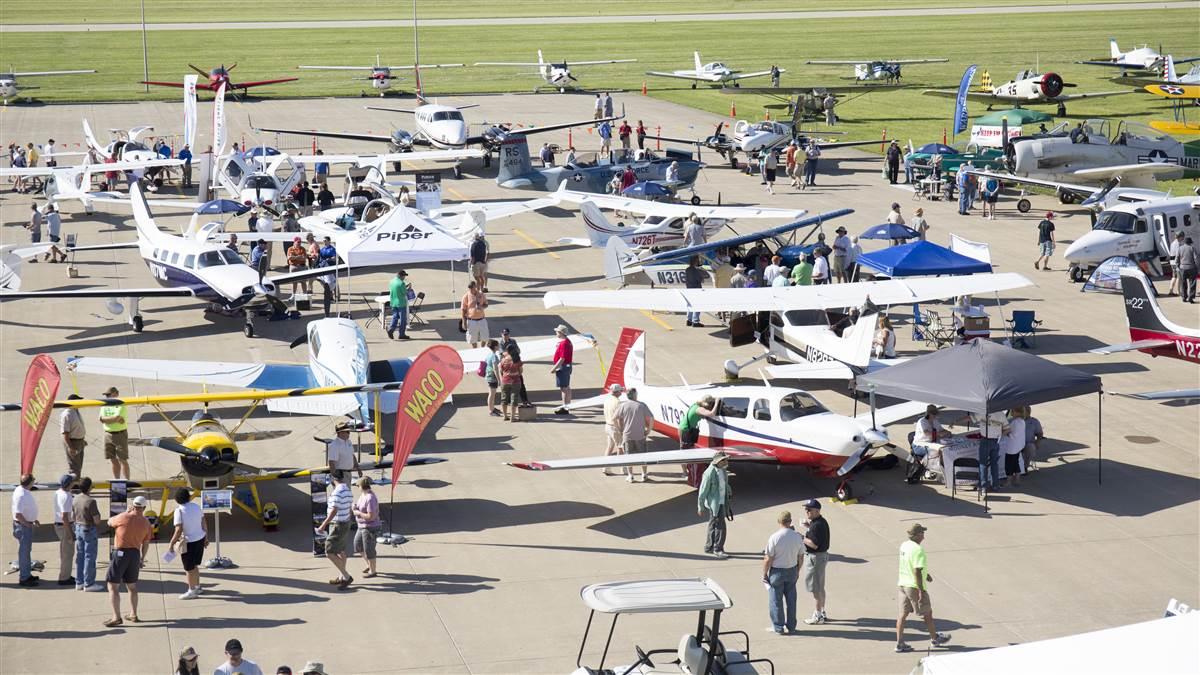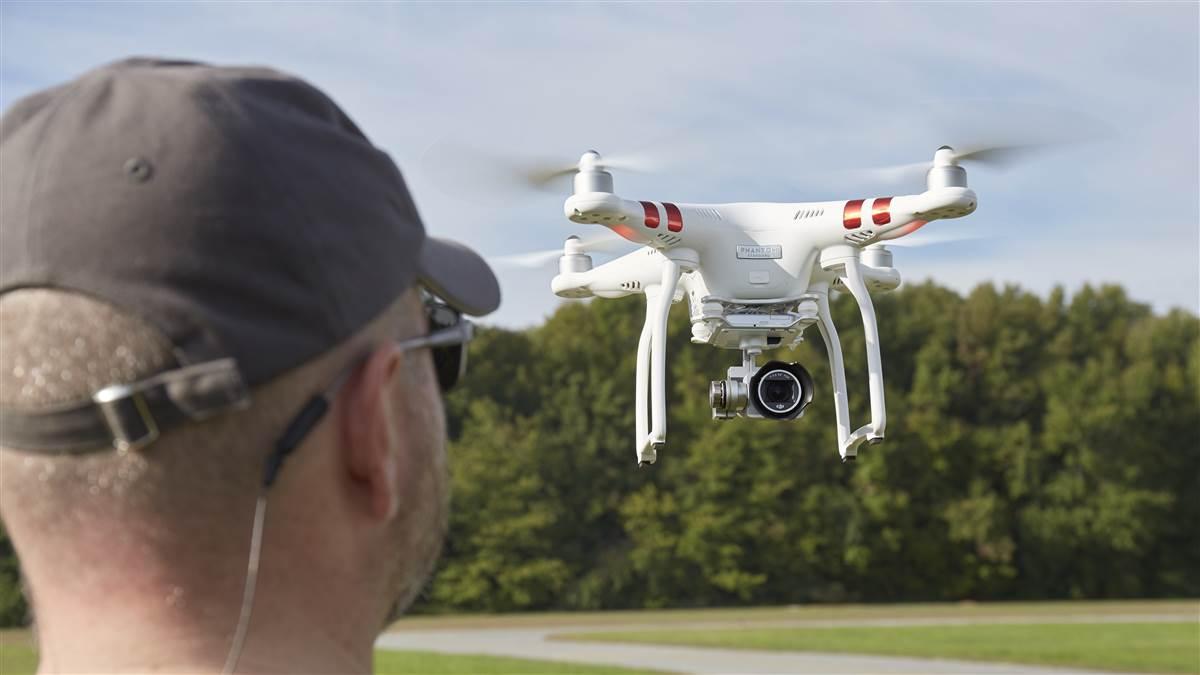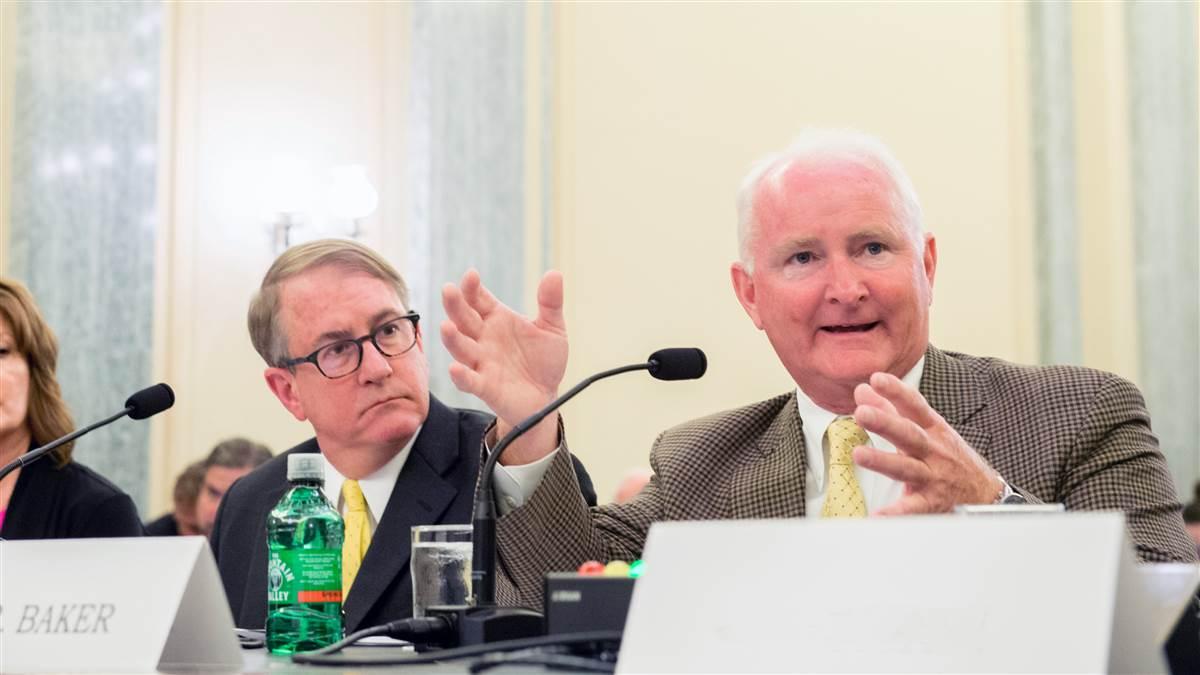AOPA Annual Report: Always vigilant
AOPA safeguards GA’s future
By AOPA Staff
Dark clouds obscured the general aviation landscape in 2017, bringing the threat not of precipitation but of a misguided attempt to turn over our nation’s air traffic control system to an organization dominated by airline special interests.

Like a low pressure system that wouldn’t move along, this threat lingered well into 2018.
Thankfully, the cold front has swept through; the bad weather has moved along, and general aviation can see clearly. As always, AOPA remains vigilant in the fight to protect the freedom of general aviation.
Storm clouds
Much of 2017 was devoted to fighting a congressional proposal that would have turned the air traffic control system over to a panel of special interests that ultimately would have been run by the airlines. AOPA and more than 250 general aviation organizations—from type clubs to state aviation groups—joined forces with consumer groups, CEOs, labor unions, small airports, and local elected officials to communicate the shortfalls and unintended consequences of the plan.
“This whole debate, for decades, has been and is about controlling the system. The proposal would not reduce the cost of flying, it would not reduce delays, and it will not speed up the deployment of NextGen technologies,” said Jim Coon, AOPA senior vice president of government affairs. “It’s a solution in search of a problem. We are fortunate to have the largest and safest system in the world and it works for all users, not just a few, so why do we want to mess with that?” Coon asked.
In 2017, we expanded the AOPA Fly-Ins to two days, offering members in-depth workshops on Friday before the Saturday main event. We saw a 76-percent growth in attendance between 2016 and 2017.Members of Congress received more than 200,000 contacts from AOPA members alone on the issue. On February 28, unable to garner the votes needed in the House of Representatives, retiring House Transportation and Infrastructure Committee Chairman Bill Shuster (R-Pa.)—the leading proponent of the bill—announced he would no longer pursue the proposal. But in April, Shuster attempted to tack an amendment onto FAA funding legislation in a last-gasp attempt to remove air traffic control from the FAA and allow it to be run by a board where airlines would have unparallelled control. We asked you once again to contact your congressional representatives, and you rallied with the intensity we’ve come to expect from our members. Shuster backed down a day later.
AOPA’s mission has always been to protect the freedom to fly. In 2017, we devoted many hours and rallied thousands of pilots by advocating on behalf of our members. But that’s only part of the formula. While fighting off the so-called “privatization” of ATC, we continue to press the other core tenets of our mission: educating pilots, nonpilots, and policymakers; and supporting activities that ensure the long-term health of GA.
Inspiring, supporting, connecting
 For more than three decades, we have faced a decline in the pilot population, losing more than 6,000 pilots per year. There’s no magic bullet to address this problem. That’s why AOPA created the You Can Fly program—it is a collection of four initiatives designed to get people flying and keep them flying. The High School, Flight Training, Flying Clubs, and Rusty Pilot initiatives are inviting more people into—or back into—aviation; improving the experience people have when they learn to fly; and keeping the pilots we have active and engaged in our community.
For more than three decades, we have faced a decline in the pilot population, losing more than 6,000 pilots per year. There’s no magic bullet to address this problem. That’s why AOPA created the You Can Fly program—it is a collection of four initiatives designed to get people flying and keep them flying. The High School, Flight Training, Flying Clubs, and Rusty Pilot initiatives are inviting more people into—or back into—aviation; improving the experience people have when they learn to fly; and keeping the pilots we have active and engaged in our community.
Along with the decline in the pilot population, the United States faces a shortage of aviation professionals: pilots, engineers, mechanics, and more. Working with professional curriculum designers, AOPA is creating a four-year high school science, technology, engineering, and math (STEM) program that falls along three tracks: pilot, aerospace engineering, and unmanned aircraft systems or drones. The courses, which are being provided to schools free of charge, include detailed lesson plans, student activities and projects, assessments, and more. The program conforms to Next Generation Science Standards and Common Core State Standards and, in keeping with career and technical education best practices, will lead to a certification or industry-accepted test—such as the FAA private pilot knowledge test, a Part 107 drone pilot certification, or a 3-D modeling software certification.
Preparing each grade level of curriculum requires courses to be developed, field tested over the course of a school year, revised, and then they can be implemented by high schools. More than 700 students at 29 schools in 17 states began field-testing the ninth-grade AOPA aviation STEM curriculum. The curriculum for tenth-graders will undergo its test phase in 2018-2019, with implementation to follow. A 2018-2019 course development timeline is planned for the eleventh grade, with testing and implementation over 2019-2021. Course development, testing, and implementation for high school seniors will emerge from 2019 to 2020.

AOPA Consolidated
Amounts in thousands (unaudited)
The bulk of AOPA’s revenue in 2017 came through membership dues and commissions and royalties. Advocacy, media, and member-focused programs, such as You Can Fly, fly-ins, and the Air Safety Institute constituted the bulk of the expenses. Not shown here is nonoperating investment income, which resulted in a positive bottom line for AOPA.
Helping pilots right now
 Meanwhile, we’re looking to improve the experience of pilots who are currently in training, as well as those who have flown many hundreds of hours and hope to fly many more.
Meanwhile, we’re looking to improve the experience of pilots who are currently in training, as well as those who have flown many hundreds of hours and hope to fly many more.
You Can Fly’s Flight Training initiative is an example. The Flight Training Experience Survey seeks flight schools and certificated flight instructors that offer top-quality training value for a pilot’s dollars. Based on pilots’ feedback through the survey, the Flight Training Experience Awards recognize those flight schools and CFIs—shining a national spotlight on the best ones. In 2017, we acknowledged 89 flight schools and 71 CFIs. To get to those top performers, we sifted through survey responses on more than 1,000 flight schools and 2,000 instructors. It doesn’t stop with a news announcement and an awards ceremony. We share these successful flight schools’ and instructors’ best practices to help other flight schools and instructors gain a similar level of quality.
The 2018 Flight Training Experience Survey opened April 9 and closes at noon August 13. Go online (www.aopa.org/ftsurvey) to nominate an outstanding flight school or flight instructor, and help other pilots find the very best aviation has to offer.
To further support training professionals and their students, the Flight Training initiative is gathering data about the sticking points that both groups face during the training process and looking for ways to reduce the friction. With the help of a Flight Training Advisory Board made up of school owners and chief flight instructors from across the country, we’re identifying the areas where schools say they need more support. In response, tools designed to simplify record keeping, give CFIs access to the insights of their peers, and make training more transparent for students are in the works.
And as we work to improve the training experience for students, we’re also working to make their training and testing more relevant. AOPA chaired an industry-led effort that has resulted in new, integrated airman certification standards and the elimination of obsolete and irrelevant test questions—gone are the questions on nondirectional beacons, transcribed weather broadcasts, and other outdated topics. Standards for private and commercial certificates, along with the instrument rating, have been published and revised yearly. Aviation maintenance technician, instructor, airline transport pilot, and rotorcraft/powered lift standards are in development.
On wings of flying clubs
Flying clubs are one of aviation’s best-kept secrets: Their members can fly more for less money; they provide access to airplanes as well as instructors; and every flying club is a ready-made community whose members support each other continually. What’s more, flying clubs offer social activities and events that give their members reasons to fly, and get everyone in the family involved.
The You Can Fly Flying Clubs initiative has been hard at work spreading the good news of flying clubs, helping to create more, and supporting existing clubs through the Flying Club Network. So far we have helped pilots launch 80 new clubs.

The AOPA Foundation Inc.
Amount in thousands (unaudited)
Educations represented the bulk of the AOPA Foundation’s expenses, in the form of grants to AOPA to support the You Can Fly program and Air Safety Institute.
Back in the air
May 1, 2018, marked the one-year anniversary of the implementation of BasicMed, an alternative to third class medical certification. As of March, less than one year from the program’s launch, more than 30,000 U.S. pilots are flying under BasicMed.
And the news keeps getting better. The Civil Air Patrol now accepts BasicMed. Pilots can fly to the Bahamas under BasicMed. Flight instructors can teach under BasicMed—a wonderful aspect of medical reform at a time when flight schools are struggling to hire and retain CFIs.
We continue to make available our free online course and extensive Fit to Fly resources (www.aopa.org/basicmed) to help pilots transition to BasicMed, or to help physicians understand the mechanics of the new rules.
The AOPA Air Safety Institute’s online and in-person training materials were accessed more than 3.6 million times last year, a 40 percent increase from the year before.Despite all the resources available, sometimes pilots take a pause in their flying—perhaps for career, family, or financial reasons. And when they want to get back in the air, the You Can Fly Rusty Pilot initiative is there to help lapsed pilots get back in the left seat. Rusty Pilot seminars, free to AOPA members, are three hours long and count toward the ground portion of a flight review. As we welcome pilots back into the fold, we’re hosting 175 seminars in 2018. Since the program’s inception, more than 5,000 lapsed pilots have gotten back in the air.
Meeting pilots where they love to fly
We are commencing our fifth year of AOPA regional fly-ins. Since launching the regional fly-ins in 2014, AOPA has hosted 20 events in 16 states, and we have connected with nearly 70,000 pilots where they fly. Our fly-ins are a terrific opportunity for members to learn more about aviation and the association—and we provide a healthy serving of fun, too.
In 2017 we expanded the fly-ins to two days, offering members in-depth workshops on Friday before the Saturday main event. We saw a 76-percent growth in attendance between 2016 and 2017—a solid indicator of the positive feedback that accompanied the new two-day format. Communities love our fly-ins because we create an economic impact of around $650,000 to $700,000 per location.
Will you be joining us at a fly-in this year? We’ll kick off the year in Missoula, Montana (MSO), June 15 and 16; followed by Santa Fe, New Mexico (SAF), September 14 and 15; Carbondale, Illinois (MDH), October 5 and 6; and Gulf Shores, Alabama (JKA), October 26 and 27.
Drone pilots
 The FAA expects general aviation to remain “stable” by most measures in the coming decades. Meanwhile, the growth of unmanned aircraft, particularly commercial drones flown under Part 107, is poised to experience a fourfold increase in five years.
The FAA expects general aviation to remain “stable” by most measures in the coming decades. Meanwhile, the growth of unmanned aircraft, particularly commercial drones flown under Part 107, is poised to experience a fourfold increase in five years.
AOPA seeks to protect the freedom to fly for everyone who loves to fly, regardless of the aircraft they choose. We are working to safely integrate drone operations within our airspace by ensuring that pilots have the appropriate level of aeronautical knowledge. We launched a drone membership and newsletter in 2017 and to date, more than 25,000 individuals receive the AOPA Drone Pilot e-newsletter. In 2018, drone pilots will see a series of videos covering topics ranging from training, safety, insurance, the legal landscape, and the regulatory environment. New AOPA drone member benefits will be added, including educational courses and conference discounts, and discounts for drones and accessories. Our new “Drones to Go” seminar is available to download for flight schools, flying clubs, or a meetup of drone enthusiasts.
Advocacy marches on
So-called ATC “privatization” is behind us, but we’re moving ahead full throttle on other advocacy fronts aimed at reducing the cost to fly. You’ve told us about a small number of airports pushing general aviation away with egregious pricing practices for fuel, ramp fees, tiedown fees, facility fees, infrastructure fees, and access fees. AOPA is working with the industry, regulators, and community leaders to ensure that public airports provide fair pricing and access to all aircraft and pilots. AOPA believes most FBOs do a great job, but there are a few bad actors.
On August 28, 2017, the association filed three FAR Part 13 complaints over egregious pricing practices at Illinois’ Waukegan National Airport; Asheville, North Carolina; and Key West, Florida. A single fixed-base operator controls the transient ramp space and fuel operations at each of these airports, and AOPA believes those airports and FBOs have failed to fulfill federal grant obligations to protect the airport for public use.
We’ve already seen results. In December 2017, the FAA published guidance to airport operators reminding them of their responsibilities to ensure fair and reasonable access and reasonable FBO pricing. And on January 30, 2018, AOPA withdrew the complaint against Waukegan after airport management took steps to address pricing and access. Waukegan now offers alternative public-use ramp space for transient aircraft at no charge.
The two remaining airports and Signature Flight Support—the sole FBO at both Asheville and Key West—dispute AOPA’s complaints. Signature argues that the two FBOs hold an exclusive lease for the entire transient general aviation parking ramp and are not bound by FAA standards designed to protect reasonable access to public ramp space. Signature contends that only the runway and taxiway are considered protected public assets.
That’s a scary precedent, according to Ken Mead, AOPA general counsel. “Airports would effectively be permitted to hand over the entire parking ramp to a single FBO without competition or other restrictions to ensure reasonable access for users. Aside from active runways or taxiways, there would be no other public assets available for transient operators, despite millions of federal and local dollars invested in these airports.”
If the parties cannot resolve their differences, AOPA likely will file a Part 16 complaint, to which the FAA would respond with a formal and binding decision.
AOPA also has released an Airport Access Watch List of 10 locations that have received numerous complaints, have only one FBO, and may be imposing unreasonable fees on pilots. AOPA will work with these locations to develop solutions.
We want to know whether you have been charged egregious fees. Submit a report to AOPA online (www.aopa.org/FBOpricing). In the meantime, we plan to expand our airport directory (www.aopa.org/airports) to include fee information where available.
Safe skies
 Safety results from knowledgeable people, skilled and proficient in their craft, operating modern, reliable equipment in a culture that promotes good decision making. General aviation reached a historically low 0.84 fatal accidents per 100,000 flight hours in 2017, in part because of AOPA’s focus on every aspect of this safety formula. The AOPA Air Safety Institute’s online and in-person training materials were accessed more than 3.6 million times last year—a 40-percent increase from the year before. The key to ASI’s reach is an aggressive pursuit to reach pilots—wherever, whenever, and however they choose to consume information with fresh, relevant content that improves knowledge and training. ASI’s YouTube channel offers videos in virtually every aspect of flight, narrated by experts with recent experience. ASI reached more than 200 locations with in-person seminars attended by over 20,000 people nationwide. The new ASI podcast series There I Was…, which captures riveting discussions with famed pilots Patty Wagstaff, Kenny G, and others, reached 50,000 downloads in less than six months. ASI produced three short videos on drone operations to engage seminar attendees on topics in AOPA’s Part 107 seminars.
Safety results from knowledgeable people, skilled and proficient in their craft, operating modern, reliable equipment in a culture that promotes good decision making. General aviation reached a historically low 0.84 fatal accidents per 100,000 flight hours in 2017, in part because of AOPA’s focus on every aspect of this safety formula. The AOPA Air Safety Institute’s online and in-person training materials were accessed more than 3.6 million times last year—a 40-percent increase from the year before. The key to ASI’s reach is an aggressive pursuit to reach pilots—wherever, whenever, and however they choose to consume information with fresh, relevant content that improves knowledge and training. ASI’s YouTube channel offers videos in virtually every aspect of flight, narrated by experts with recent experience. ASI reached more than 200 locations with in-person seminars attended by over 20,000 people nationwide. The new ASI podcast series There I Was…, which captures riveting discussions with famed pilots Patty Wagstaff, Kenny G, and others, reached 50,000 downloads in less than six months. ASI produced three short videos on drone operations to engage seminar attendees on topics in AOPA’s Part 107 seminars.
AOPA’s ASI and You Can Fly teams are working on a joint project to promote more flying, more affordably, which improves pilot training and proficiency. The teams are working to enhance safety at flying clubs through easy-to-access online resources. ASI and You Can Fly teams are also working to integrate ASI safety materials into the flight training curriculum currently being developed.
AOPA’s relentless pursuit of Part 23 reform is resulting in an influx of new, affordable equipment entering the market, with proven safety performance. The final rule that reforms small aircraft certification standards went into effect in August 2017 and allows manufacturers to use performance-based consensus standards in lieu of prescriptive standards that have hindered the development and implementation of new technologies in new aircraft, as well as the existing fleet.
We are already seeing an influx of new, lower-cost glass panel, autopilot, and angle of attack systems for many makes and models of the legacy fleet, with more coming out all the time. These products are making the transition from Experimental to certificated aircraft, and we can’t wait for the next round of innovations.
All of AOPA’s efforts are united in a focused effort to help general aviation reach greater heights and work even harder to keep our skies open and safe. With your help, we can weather any storm.


